1870 – 1956
Also known as Victoria
Back in the 1860s, the transatlantic shipping industry was still in its cradle. The most powerful company operating ships across the North Atlantic was the British Cunard Line, which had inaugurated their sailings in 1840 with their first steamer – Britannia. Cunard had been faced with fierce competition in the guise of the American Collins Line during the 1850s, but since the Collins ships had an extraordinary ability to get into trouble or even founder, the Collins Line went bankrupt in the early 1860s. For the time being, Cunard was the sole giant.
But to maintain their position as the largest shipping company on the North Atlantic route, Cunard had to operate a fleet of modern ships. In the late 1860s, the company decided to order a new trio of modern, state-of-the-art ships. And to have them all completed as soon as possible, the ships were to be built at different shipyards. The two first ships, which were to be named Abyssinia and Algeria, would be built by the Glasgow firm of J & G Thomson. The third ship was contracted to William Denny & Bros., Dumbarton.
On February 2nd 1870, the keel was laid on what was to be the finest ship yet of the Cunard fleet. Over the months, work progressed at a steady pace, until the day of launch finally arrived on September 10th that same year. Christened Parthia, the new ship would soon be ready to enter service for her owners.
At first glance, the Parthia probably looked more or less identical to her two older sisters. Like them, she had a flush-deck, an open bridge, three masts rigged for sail and a single funnel. The trio was the finest so far in Cunard service, and they were the first of the company’s ships to have bathrooms – one on the port side, and one on the starboard side. However, there were some significant differences between the three sisters. Some 200 gross tons smaller than her siblings, Parthia had been designed as a smaller, yet superior unit of the class. She had been fitted with compound engines, more efficient than those of her sisters, and required only half the amount of coal to achieve the same service speed. Subsequently, she did not require as much coal storage space. One could also tell the ships apart by the Parthia’s thinner funnel, which was located slightly closer to the mainmast than it was on her sisters.
Finally, on December 17th 1870, Parthia set out on her maiden voyage, leaving Liverpool bound for New York. She had cost £94,970 to complete, and it was now up to the ship to prove her worth. Crossing the North Atlantic with a service speed of nearly 13 knots, the Parthia did not disappoint her owners. However, although she was a propeller ship, her speed was not enough to take the westbound Blue Riband from another Cunarder – the paddle steamer Scotia. Nevertheless, Parthia had performed satisfactory, and she now settled into to her service, soon becoming well acquainted with the swell of the North Atlantic.
For the time being, she was one of the superior ships on the Atlantic, but it was not long before Parthia was outmoded by new vessels. In 1871, the new White Star Line opened business with their first steamer, the Oceanic, which surpassed Parthia in both length and size as well as in comfort. Still, Parthia continued serving the Cunard Line for a little more than a decade. But this was a time of great technological advances, and by the 1880s the Parthia was no longer a state-of-the-art liner. But she was still a ship of calibre, and she proved this when she was called in to serve as a troop transport during General Gordon’s Egyptian campaign in 1881.
When the ship was returned to her owners, Cunard was aiming for new goals, and it wasn’t certain that there was a place for Parthia in the company’s future fleet. And so, after having completed her 119th voyage, the Parthia was laid up at Liverpool in November of 1883.
In 1884, the next chapter in Parthia’s career began. Cunard had ordered two new vessels, Umbria and Etruria, from the yards of John Elder & Co. When they were completed, the Parthia was acquired as part payment for the new pair of liners. Umbria and Etruria both went on to win the Blue Riband for Cunard, but the Parthia’s days as a Cunarder were now over. The man who owned the Elder yard, Sir William Pearce MP, was also the owner of the Guion Line. So, the Parthia was now transferred to Guion ownership, and after she had been refitted with new, triple-expansion engines in 1885, the ship entered service for her new owners on runs to Australia, the Hebrides and South America.
In 1887 however, she would soon see a new change of her life. The Canadian Pacific Railway Co. was about to inaugurate their trans-Pacific service, but the ordered vessels had not yet been completed. So, together with several other ships, the Parthia was placed in Canadian Pacific service. Once more sailing another ocean, she made her maiden arrival at the port of Vancouver on July 4th 1887.
Four years later, on August 20th 1891, Parthia made her 20th and final sailing for the Canadian Pacific Railway Co. Returned to the Guion Line, she was taken in for a modernisation refit. She emerged in 1892 with only two masts and with the new name Victoria. Soon afterwards, the ship was transferred to the Northern Pacific Steamship Co., and placed on their Tacoma-Hong Kong service. All of a sudden, the Victoria was in competition with her old fleet mates of Canadian Pacific. But neither this part of the ship’s career would be very long.
Six years later, in October of 1898, the Victoria was again transferred to new owners. This time, it was the North American Mail SS Co. who acquired and started operating her under the US flag. The following year, the Victoria’s American registry enabled the authorities to requisition her for trooping duties during the Spanish-American war of 1899-1900. Victoria was used to transport soldiers to Manila, but she only completed three such voyages.
When she was returned to her owners in 1900, gold fever struck Puget Sound and Victoria was used to carry hundreds of eager prospectors to Nome. In October the following year, the ship was reverted to her former owners, the Northern Pacific SS Co. She only stayed with them for a further three years though, before she was again sold in 1904, this time to the Northwestern SS Co. and placed in Alaska service, where her inch-thick iron hull soon proved to have excellent ice-breaking abilities. She soon saw war action again, when in 1905 she was used as a blockade runner during the Russo-Japanese war, carrying supplies to the Russian port of Vladivostok.
In February of 1908 however, the eight-ship fleet of Northwestern SS Co. was acquired by the Alaska SS Co. The soon 40-year old Victoria was still looked upon as useful, and she was placed on the company’s San Francisco-Seattle-Nome route. There she remained for several years, and in 1924 it was decided to give the now 54-year old vessel a refit in order to reach contemporary standards. Victoria was re-engined, given new boilers and converted to oil fuel, and her appearance was much altered when her decks were raised, the superstructure was added to and the bridge was enclosed. As a result of this extensive refit, the ship emerged with a higher passenger capacity as well as more comfortable accommodations. In many ways a virtually new ship, the Victoria then returned to service once again.
In 1934, the Victoria had the honour of making the very first Arctic cruise of the Alaska SS Co. During the voyage she called at Nome and Kotzebue before proceeding to the Arctic ice pack, coming as close as four miles of Wrangell Island, Siberia. But, by now time was really starting to catch up with the old Victoria. In 1935 she was laid up for three years at Lake Union due to the cost of meeting US safety and fire precautions. Five years later, in 1940, her passenger accommodations were removed and she was converted to carry cargo only. During the Second World War, Victoria was operated by the US War Administration and from 1941 to 1947 she made 46 voyages to Alaska.
After the war, there did not seem to be much work for the Victoria. In 1952, she was sold to Dulien Steel Products for breaking up, and she was placed in lay-up at Houghton, Lake Washington. An inspection showed that the old iron hull was still sound, and amazingly the ship managed to escape the breakers in spite of her age.
In 1954, the Victoria was purchased by the Straits Towing & Salvage Co. of Vancouver. Needless to say, they did not have a glorious career in mind for the old ship, and had her converted into the log-carrying barge Straits No. 27. Fortunately, she would not remain in this degrading service for long. In 1956, what was left of the former Parthia was sold to Japanese breakers. Renamed Straits Maru for her final voyage, she was loaded with scrap iron and towed to Osaka by the tug Sudbury. She arrived there on October 16th 1956, and the dismantling process would soon begin. The Parthia reached an astonishing age of 86 years.
Specifications
- 360.5 feet (110.1 m) long
- 40.3 feet (12.3 m) wide
- 3,167 gross tons
- Compound steam engines, turning a single propeller
- 13 knot service speed
- Passenger capacity of 200 people in 1st class, 1,050 in 3rd class

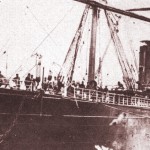
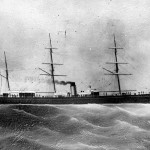
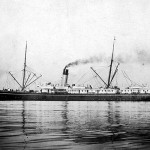
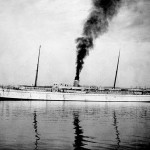
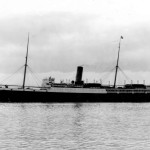
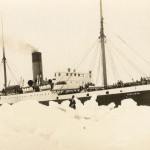
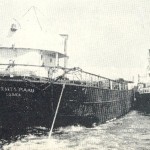
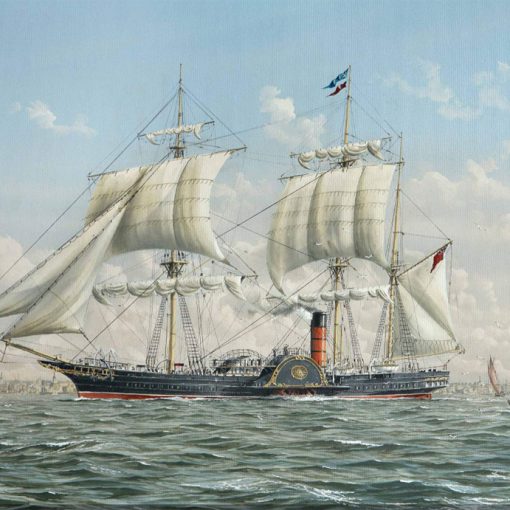
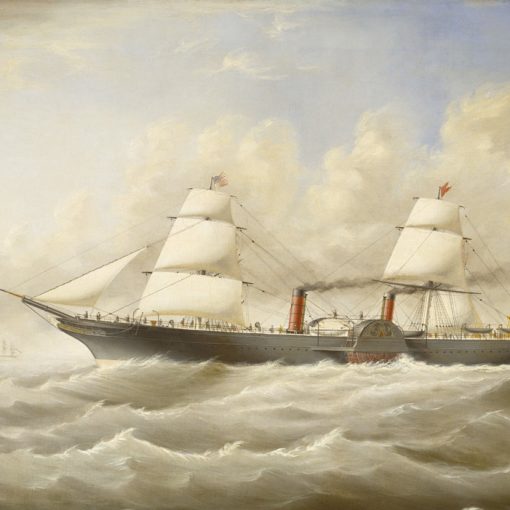
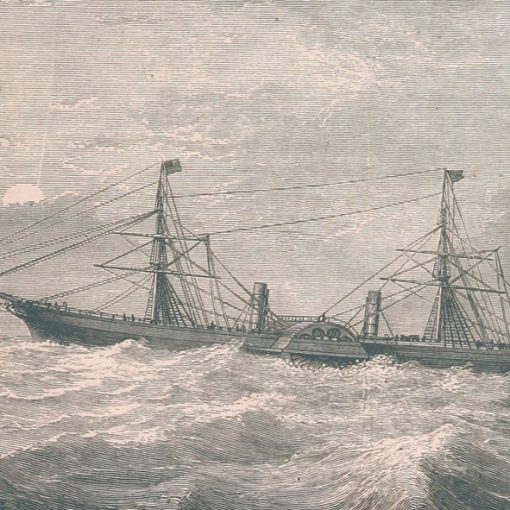
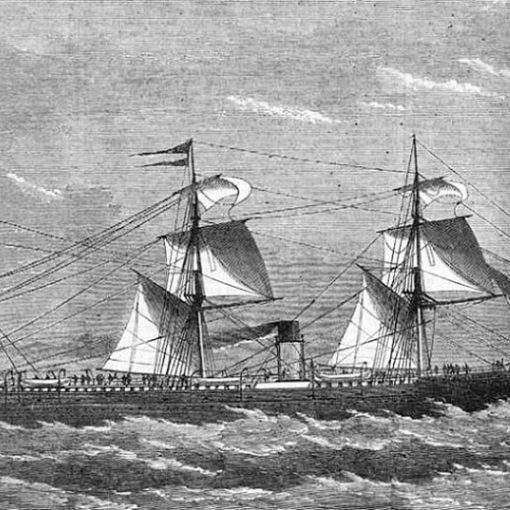
One thought on “Parthia (I)”
Thank you for this information. I have discovered my great grandfather’s memoir and he tells of his journey aboard the Parthia returning from the USA to Liverpool, probably 1884-87, smuggling aboard his pet raccoon and causing mayhem!!!